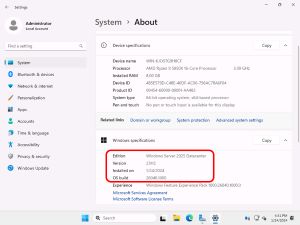News
Amid 'Apple Intelligence' Hype, Windows Server 2025 Banks on NVIDIA AI
Shortly before Apple's big "Apple Intelligence" event that saw the tech giant finally jump on the AI bandwagon, Microsoft reminded everyone it still has a big lead in that area with wares like Windows Server 2025 thanks to its early partnerships with companies like OpenAI and NVIDIA.
The latter company has benefitted as much as anybody from the generative AI craze thanks to its AI-friendly graphical processing units (GPUs) and other hardware/software offerings that help facilitate resource-intensive AI model training, deep learning inferencing and other AI tasks.
Last week, just days before Apple's big AI event, Microsoft showcased the GPU benefits resulting from its NVIDIDA partnership in an article titled "Introducing GPU Innovations with Windows Server 2025."
Along with contrasting Microsoft with Apple in terms of AI innovation, the article might also have been intended to highlight the consumer/IT differences between the two companies, with Apple focusing on phones/devices AI and Microsoft on enterprise solutions.
"GPUs are essential for AI due to their parallel processing capabilities and highly scalable architecture," said the article authored by Afia Boakye and Rebecca Wambua on Microsoft's Tech Community site, discussing Windows Server 2025 Datacenter and Azure Stack HCI 24H2. "Using the upcoming OS releases, Microsoft's customers can provide an entire GPU to a VM, which can run either Linux or Server, in a failover cluster using discrete device assignment (DDA). This means that mission-critical AI workloads can easily run in a clustered VM and, upon an unexpected fault or a planned move, the VM will restart on another node in the cluster, using a GPU on that node.
 [Click on image for larger view.] Windows Server 2025 Datacenter (source: Microsoft).
[Click on image for larger view.] Windows Server 2025 Datacenter (source: Microsoft).
"GPU Partitioning (GPU-P) is a powerful new capability we are adding with Windows Server 2025. GPU-P empowers customers to partition a supported GPU and assign those partitions to different VMs in a failover cluster. This means that multiple VMs can share a single physical GPU, giving each VM an isolated fraction of the physical GPU's capabilities."
Announced in preview on May 29, Windows Server 2025 is now in preview and is expected to be generally available later this year. That May announcement highlighted AI capabilities such as GPU partitioning across VMs with live migration and failover clustering, along with built-in support for AI workloads and inferencing at the edge.
Citing "AI, performance and scale," the company said at the time: "Are you curious about how your organization can do more with AI? Well, you've come to the right place! Azure hosts some of the world's largest workloads that push the limits of CPU and memory capabilities to process huge data sets across distributed environments. With the growth of AI and machine learning, GPUs have become a key part of cloud solutions because they're great at performing many parallel operations on large data. Windows Server 2025 brings you many of these advantages across GPUs, storage, networking, and scalability."
GPU partitioning was also mentioned in last week's announcement, helping users partition a supported GPU and assign those partitions to different VMs in a failover cluster, resulting in multiple VMs that can share a single physical GPU, giving each VM an isolated fraction of the physical GPU's capabilities.
"Further, due to a planned or unplanned move, the VMs will restart on different nodes in the cluster, using GPU partitions on those different nodes," Microsoft said. "Besides enabling clustered VMs to use GPU-P, the upcoming OS releases are bringing live migration to VMs using GPU-P. Live migration for GPU-P enables customers to balance mission-critical workloads across their fleet and to conduct hardware maintenance and software upgrades without stopping their VMs."
Yesterday, meanwhile, John K. Waters reported on Apple's catch-up play: "Apple unveiled 'Apple Intelligence,' a comprehensive software update across its devices, including iOS 18, iPadOS 18, and macOS Sequoia, aiming to provide users with a personalized version of generative AI (GenAI)."
Apple uses its own silicon such as A17 Pro and M1 chips in its Apple Intelligence initiative, rolling out in beta this summer for users in the U.S., with a full release as part of iOS 18, iPadOS 18 and macOS Sequoia this fall.
About the Author
David Ramel is an editor and writer at Converge 360.